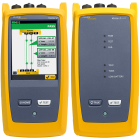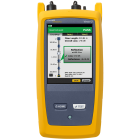Bandwidth and Data Rates
October 17, 2019 / General, 101 learning, Best Practices
The terms bandwidth and data rates are often used interchangeably, but they are in fact very different if you work in the cabling world.
Your internet provider may advertise a bandwidth of 500 megabits per second (Mbps). In that case, they actually mean data rate. In the cabling world, bandwidth is a property of the cable – its ability to transmit a signal that’s intelligible at the far end.
Any signal put on a copper or fiber link will degrade as it gets to the far end. This is a result of simple loss, but also more complex factors such as return loss (reflections), and in the case of copper, crosstalk. Vendors design their copper and fiber cabling to be able to deliver these raw signals (bandwidth) at higher rates.
When it comes to copper cabling, you’ve probably heard of Category 6 as having a bandwidth of 250 MHz and Category 6A as having a bandwidth of 500 MHz. (The bandwidth is often printed on the cable jacket.) This creates plenty of confusion since we think of bandwidth on the network as expressed in Mb/s or Gb/s. We are not wrong in that mindset – your Category 6A cable may have an operating bandwidth of 500 MHz, while your network may have a bandwidth of 10 Gb/s.
So why is category cable bandwidth defined as MHz? Good question. Megahertz is the frequency or rate at which a wave will cycle each second, with 1 hertz equal to 1 cycle per second and 1 MHz equal to 1 million cycles per second. The relationship of speed to frequency is a bit complex, but in simple terms, higher frequencies are needed to carry more bits of data. Each data bit is encoded on a carrier frequency, and the amount of data that can be transmitted per second depends on the signal encoding scheme of the active equipment.
Back in the days of Cat 5, the bandwidth and the data rates were the same – 100 MHz cabling could deliver 100 Mb/s. But designers of network interfaces have been able to develop encoding schemes such as pulse amplitude modulation (PAM) and DSQ128 to go beyond the simple 1:1 relationship of bandwidth to data rate. By the time Cat 6 came out, they were able to drive 10 Gbps over a cable with a bandwidth of 250 MHz. This approach is how NBASE-T is able to get 2.5 and even 5 Gbps out of Cat 5e cable and how your cable provider gets you faster internet speeds without recabling the connection to your house.
|
Cabling Standard* |
Maximum Bandwidth |
Supported Network Standards** |
|||||
|
TIA |
ISO |
|
10BASE-T |
100BASE-TX |
1000BASE-T |
10GBASE-T |
25/40GBASE-T |
|
Cat 5 |
|
100 MHz |
X |
X |
|
|
|
|
Cat 5e |
Class D |
100 MHz |
X |
X |
X |
|
|
|
Cat 6 |
Class E |
250 MHz |
X |
X |
X |
(35 m max) |
|
|
Cat 6A |
Class EA |
500 MHz |
X |
X |
X |
X |
|
|
Cat 8 |
Class I, II |
2000 MHz |
X |
X |
X |
X |
(30 m max) |
Dispersion Aversion
When it comes to multimode fiber optic cabling, we see a specification for effective modal bandwidth (EMB). Measured as Megahertz over 1 Kilometer (expressed as MHz-km), EMB determines how much data a specific fiber can transmit at a given wavelength, and it is dependent on various characteristics of the fiber. EMB is length dependent, and fiber with an EMB of 200 MHz-km fiber can move 200 MHz of data up to one kilometer. A higher EMB can move more data up to one kilometer, or it can move the same amount of data further distances.
With multimode fiber, EMB is affected by the differential mode delay of a fiber, or DMD. When multiple modes of light travel through a multimode fiber, some travel faster down the center, while others travel slower along pathways closer to the core-cladding interface. DMD is the difference in travel time between the fastest mode and the slowest, and fiber manufacturers design their fiber to limit DMD and allow for higher bandwidth.
For singlemode fiber, modal bandwidth is essentially limitless and there is no associated EMB value since there is only one mode of light traveling through the fiber. While the bandwidth of singlemode is essentially infinite, it is affected by the capabilities of the electronics and chromatic dispersion, which is the result of different wavelengths (not modes) reaching the transceiver at slightly different times.
What Matters Most
While cabling specifications for bandwidth cause plenty of confusion, don’t let those values get in the way of what really matters. When you test to an application, say 10GBASE-T, you’re testing for ability of that specific link to support 10 Gb/s speeds. Just remember that your 10 Gig file isn’t likely to transmit across the network in about a second, unless yours is the only data being transmitted directly from one point to another.
Learn more about Versiv Copper and Fiber Cable Certifiers








